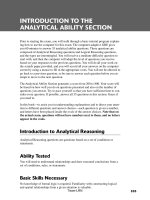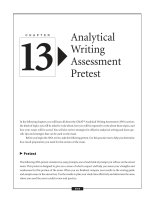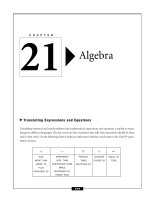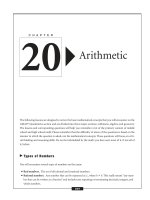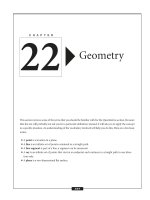The GMAT Quantitative Section - Arithmetic
Bạn đang xem bản rút gọn của tài liệu. Xem và tải ngay bản đầy đủ của tài liệu tại đây (137.7 KB, 18 trang )
The following lessons are designed to review the basic mathematical concepts that you will encounter on the
GMAT® Quantitative section and are divided into three major sections: arithmetic, algebra, and geometry.
The lessons and corresponding questions will help you remember a lot of the primary content of middle
school and high school math. Please remember that the difficulty of many of the questions is based on the
manner in which the question is asked, not the mathematical concepts. These questions will focus on criti-
cal thinking and reasoning skills. Do not be intimidated by the math; you have seen most of it, if not all of
it, before.
Types of Numbers
You will encounter several types of numbers on the exam:
■
Real numbers. The set of all rational and irrational numbers.
■
Rational numbers. Any number that can be expressed as , where b 0. This really means “any num-
ber that can be written as a fraction” and includes any repeating or terminating decimals, integers, and
whole numbers.
a
b
CHAPTER
Arithmetic
20
321
■
Irrational numbers. Any nonrepeating, nonterminating decimal (i.e., ͙2
ෆ,
, 0.343443444 ...).
■
Integers. The set of whole numbers and their opposites {...,–2,–1,0,1,2,3,...}.
■
Whole numbers. {0,1,2,3,4,5,6,...}.
■
Natural numbers also known as the counting numbers. {1,2,3,4,5,6,7,...}.
Properties of Numbers
Although you will not be tested on the actual names of the properties, you should be familiar with the ways
each one helps to simplify problems. You will also notice that most properties work for addition and multi-
plication, but not subtraction and division. If the operation is not mentioned, assume the property will not
work under that operation.
Commutative Property
This property states that even though the order of the numbers changes, the answer is the same. This prop-
erty works for addition and multiplication.
Examples
a + b = b + a ab = ba
3 + 4 = 4 + 3 3 × 4 = 4 × 3
7 = 7 12 = 12
Associative Property
This property states that even though the grouping of the numbers changes, the result or answer is the same.
This property also works for addition and multiplication.
a + (b + c) = (a + b) + ca(bc) = (ab)c
2 + (3 + 5) = (2 + 3) + 5 2 × (3 × 5) = (2 × 3) × 5
2 + 8 = 5 + 5 2 × 15 = 6 × 5
10 = 10 30 = 30
Identity Property
Two identity properties exist: the Identity Property of Addition and the Identity Property of Multiplication.
A
DDITION
Any number plus zero is itself. Zero is the additive identity element.
a + 0 = a 5 + 0 = 5
–
ARITHMETIC
–
322
M
ULTIPLICATION
Any number times one is itself. One is the multiplicative identity element.
a × 1 = a 5 × 1 = 5
Inverse Property
This property is often used when you want a number to cancel out in an equation.
A
DDITION
The additive inverse of any number is its opposite.
a + (–a ) = 0 3 + (–3) = 0
M
ULTIPLICATION
The multiplicative inverse of any number is its reciprocal.
a × = 1 6 × = 1
Distributive Property
This property is used when two different operations appear: multiplication and addition or multiplication
and subtraction. It basically states that the number being multiplied must be multiplied, or distributed, to
each term within the parentheses.
a (b + c) = ab + ac or a (b – c) = ab – ac
5(a + 2) = 5 × a + 5 × 2, which simplifies to 5a + 10
2(3x – 4) = 2 × 3x – 2 × 4, which simplifies to 6x – 8
Order of Operations
The operations in a multistep expression must be completed in a specific order. This particular order can be
remembered as PEMDAS. In any expression, evaluate in this order:
PParentheses/grouping symbols first
E then Exponents
MD Multiplication/Division in order from right to left
AS Addition/Subtraction in order from left to right
Keep in mind that division may be done before multiplication and subtraction may be done before addi-
tion, depending on which operation is first when working from left to right.
1
6
1
a
–
ARITHMETIC
–
323
Examples
Evaluate the following using the order of operations:
1. 2 × 3 + 4 – 2
2. 3
2
– 16 – (5 – 1)
3. [2 (4
2
– 9) + 3] –1
Answers
1. 2 × 3 + 4 – 2
6 + 4 – 2 Multiply first.
10 – 2 Add and subtract in order from left to right.
8
2. 3
2
– 16 + (5 – 1)
3
2
– 16 + (4) Evaluate parentheses first.
9 – 16 + 4 Evaluate exponents.
–7 + 4 Subtract and then add in order from left to right.
–3
3. [2 (4
2
– 9) + 3] – 1
[2 (16 – 9) + 3] – 1 Begin with the innermost grouping symbols and follow PEMDAS. (Here,
exponents are first within the parentheses.)
[2 (7) + 3] – 1 Continue with the order of operations, working from the inside out (sub-
tract within the parentheses).
[14 + 3] – 1 Multiply.
[17] – 1 Add.
16 Subtract to complete the problem.
Special Types of Defined Operations
Some unfamiliar operations may appear on the GMAT exam. These questions may involve operations that
use symbols like #, $, &, or @. Usually, these problems are solved by simple substitution and will only involve
operations that you already know.
Example
For a # b defined as a
2
– 2b, what is the value of 3 # 2?
a. –2
b. 1
c. 2
d. 5
e. 6
–
ARITHMETIC
–
324
For this question, use the definition of the operation as the formula and substitute the values 3 and 2
for a and b, respectively. a
2
– 2b = 3
2
– 2(2) = 9 – 4 = 5. The correct answer is d.
Factors, Multiples, and Divisibility
In the following section, the principles of factors, multipliers, and divisibility are covered.
Factors
A whole number is a factor of a number if it divides into the number without a remainder. For example, 5 is
a factor of 30 because without a remainder left over.
On the GMAT exam, a factor question could look like this:
If x is a factor of y, which of the following may not represent a whole number?
a. xy
b.
c.
d.
e.
This is a good example of where substituting may make a problem simpler. Suppose x = 2 and y = 10 (2 is a
factor of 10). Then choice a is 20, and choice c is 5. Choice d reduces to just y and choice e reduces to just x,
so they will also be whole numbers. Choice b would be
ᎏᎏ
1
2
0
ᎏ
, which equals
ᎏ
1
5
ᎏ
, which is not a whole number.
Prime Factoring
To prime factor a number, write it as the product of its prime factors. For example, the prime factorization
of 24 is
24 = 2 × 2 × 2 × 3 = 2
3
× 3
24
12
6
2
2
3
2
xy
y
yx
x
y
x
x
y
30 Ϭ 5 ϭ 6
–
ARITHMETIC
–
325
Greatest Common Factor (GCF)
The greatest common factor (GCF) of two numbers is the largest whole number that will divide into either
number without a remainder. The GCF is often found when reducing fractions, reducing radicals, and fac-
toring. One of the ways to find the GCF is to list all of the factors of each of the numbers and select the largest
one. For example, to find the GCF of 18 and 48, list all of the factors of each:
18: 1, 2, 3, 6, 9, 18
48: 1, 2, 3, 4, 6, 8, 12, 16, 24, 48
Although a few numbers appear in both lists, the largest number that appears in both lists is 6; there-
fore, 6 is the greatest common factor of 18 and 48.
You can also use prime factoring to find the GCF by listing the prime factors of each number and mul-
tiplying the common prime factors together:
The prime factors of 18 are 2 × 3 × 3.
The prime factors of 48 are 2 × 2 × 2 × 2 × 3.
They both have at least one factor of 2 and one factor of 3. Thus, the GCF is 2 × 3 = 6.
Multiples
One number is a multiple of another if it is the result of multiplying one number by a positive integer. For
example, multiples of three are generated as follows: 3 × 1 = 3, 3 × 2 = 6, 3 × 3 = 9, 3 × 4 = 12, . . . There-
fore, multiples of three can be listed as {3, 6, 9, 12, 15, 18, 21, ...}
Least Common Multiple (LCM)
The least common multiple (LCM) of two numbers is the smallest number that both numbers divide into
without a remainder. The LCM is used when finding a common denominator when adding or subtracting
fractions. To find the LCM of two numbers such as 6 and 15, list the multiples of each number until a com-
mon number is found in both lists.
6: 6, 12, 18, 24, 30, 36, 42, . . .
15: 15, 30, 45, . . .
As you can see, both lists could have stopped at 30; 30 is the LCM of 6 and 15. Sometimes it may be faster
to list out the multiples of the larger number first and see if the smaller number divides evenly into any of
those multiples. In this case, we would have realized that 6 does not divide into 15 evenly, but it does divide
into 30 evenly; therefore, we found our LCM.
Divisibility Rules
To aid in locating factors and multiples, some commonly known divisibility rules make finding them a little
quicker, especially without the use of a calculator.
–
ARITHMETIC
–
326
■
Divisibility by 2. If the number is even (the last digit, or units digit, is 0, 2, 4, 6, 8), the number is
divisible by 2.
■
Divisibility by 3. If the sum of the digits adds to a multiple of 3, the entire number is divisible by 3.
■
Divisibility by 4. If the last two digits of the number form a number that is divisible by 4, then the
entire number is divisible by 4.
■
Divisibility by 5. If the units digit is 0 or 5, the number is divisible by 5.
■
Divisibility by 6. If the number is divisible by both 2 and 3, the entire number is divisible by 6.
■
Divisibility by 9. If the sum of the digits adds to a multiple of 9, the entire number is divisible by 9.
■
Divisibility by 10. If the units digit is 0, the number is divisible by 10.
Prime and Composite Numbers
In the following section, the principles of prime and composite numbers are covered.
Prime Numbers
These are natural numbers whose only factors are 1 and itself. The first ten prime numbers are 2, 3, 5, 7, 11,
13, 17, 19, 23, and 29. Two is the smallest and the only even prime number. The number 1 is neither prime
nor composite.
Composite Numbers
These are natural numbers that are not prime; in other words, these numbers have more than just two fac-
tors. The number 1 is neither prime nor composite.
Relatively Prime
Two numbers are relatively prime if the GCF of the two numbers is 1. For example, if two numbers that are
relatively prime are contained in a fraction, that fraction is in its simplest form. If 3 and 10 are relatively prime,
then is in simplest form.
Even and Odd Numbers
An even number is a number whose units digit is 0, 2, 4, 6, or 8. An odd number is a number ending in 1, 3,
5, 7, or 9. You can identify a few helpful patterns about even and odd numbers that often arise on the Quan-
titative section:
odd + odd = even odd × odd = odd
even + even = even even × even = even
even + odd = odd even × odd = even
3
10
–
ARITHMETIC
–
327
